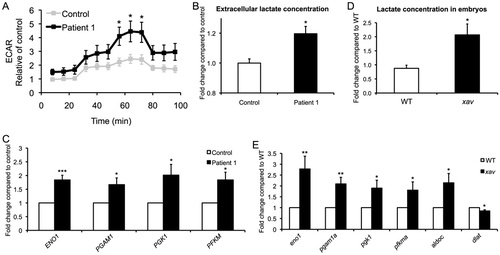
Increased aerobic glycolysis in MADD fibroblasts and mutants. A. ECAR was measured in intact control and MADD Patient 1 fibroblasts under basal conditions, following the addition of the mitochondrial inhibitor oligomycin (0.5 µg/ml), in the presence of the uncoupler CICCP (3 µM) and following the addition of the complex I inhibitor rotenone (100 nM). A trend towards higher ECAR rate was seen under basal conditions, and a significant 2-fold increase was observed after uncoupler CICCP treatment in Patient 1 fibroblasts compared to control. (N = 3 experiments, 7?9 replicates of cells from passage 7?12; Student\′s t test, * p<0.05). B. Lactate present in the culture medium showed a ~20% increase in the basal lactate production in Patient 1 fibroblasts compared to control (N = 2 experiments, 5?6 replicates of cells from passage 7?8; Student′s t test, * p<0.05). C. qRT-PCR analyses of genes involved in glycolysis showed glycolytic enzymes enolase 1 (ENO1), phosphoglycerate mutase 1 (PGAM1), phosphoglycerate kinase 1 (PGK1) and phosphofructokinase (PFKM), were increased by ~1.9, 2.7, 3.4 and 3.1 fold respectively in Patient 1 fibroblasts compared to control (N = 5 replicates of cells from passage 7?9; Student′s t test, * p<0.05, *** p<0.001). D. Lactate levels showed a ~2.4 fold increase in xav mutants compared to WT embryos at ~56 hpf (N = 7?9 replicates, 30?100 embryos each; Student′s t test, * p<0.05). E. qRT-PCR analyses of gene expression revealed increased expression of glycolytic enzymes eno1, pgam1a, pgk1, pfkma, and fructose-biphosphate aldolase C (aldoc) by 2.8, 2, 1.9, 1.8 and 2.1 fold respectively, as well a ~20% decrease in dihydrolipoamide S-acetyltransferase (dlat), that belongs to the pyruvate dehydrogenase complex, which links glycolysis to tricarboxylic acid (TCA) cycle, in xav mutants compared to WT embryos at ~56 hpf (N = 3?7 replicates, 20 embryos each; Student\′s t test, * p<0.05, ** p<0.01).
|

